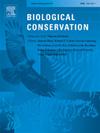Temperature and precipitation influence the distribution of different Cyperaceae life forms: The role of protected areas in the Amazon for conservation
IF 4.9
1区 环境科学与生态学
Q1 BIODIVERSITY CONSERVATION
引用次数: 0
Abstract
Climate change is the main cause of global biodiversity loss and changes in the structure of ecological communities. Species distribution models are an efficient tool for predicting suitable areas for species and their vulnerability to climate change. In this study, we evaluated the impact of precipitation and temperature (factors of climate change) on 12 species of the Cyperaceae family, classified into three groups: aquatic, amphibian, and terrestrial. Our results provide a comprehensive overview of habitat projections for aquatic, amphibian and terrestrial Cyperaceae species in the Amazon biome under current and future scenarios. We highlight significant range losses projected for species such as Scleria amazonica and Cyperus lacustris in the future. The relationship between climate and its influence on species distribution is critical, emphasizing the urgent need to conserve biodiversity in the face of climate change. In the models, protected areas were essential refuges for species under threat, highlighting their crucial role in preventing biodiversity loss. Variables such as temperature and seasonality (rainfall variability) strongly influenced the distribution patterns of Cyperaceae species. Seasonal fluctuations such as extreme droughts can influence water availability and the growth dynamics of hydrophytic plants. Amphibian species adapt to temperature fluctuations and changes in precipitation, while terrestrial plants prefer warmer and rainy regions. Our results emphasize the importance of conservation strategies for Amazonian species. We have also shown that protected areas play an essential role in conserving biodiversity and protecting Cyperaceae species from future changes.
温度和降水对不同苏科生命形式分布的影响:亚马逊地区保护区的保护作用
气候变化是全球生物多样性丧失和生态群落结构变化的主要原因。物种分布模型是预测物种适宜生长区域及其对气候变化脆弱性的有效工具。本文研究了降水和温度(气候变化因子)对苏科12种植物(水生、两栖和陆生)的影响。我们的研究结果全面概述了在当前和未来情景下亚马逊生物群系中水生、两栖和陆生苏科物种的栖息地预测。我们强调了在未来,诸如亚马孙sccleria amazonica和湖莎草(Cyperus lacustris)等物种的显著范围损失。气候及其对物种分布的影响之间的关系至关重要,强调在气候变化面前迫切需要保护生物多样性。在这些模型中,保护区是受威胁物种的基本避难所,突出了它们在防止生物多样性丧失方面的关键作用。温度和季节(降雨变率)等变量对苏科植物的分布格局有很大影响。极端干旱等季节性波动会影响水的可用性和水生植物的生长动态。两栖动物适应温度波动和降水变化,而陆生植物更喜欢温暖多雨的地区。我们的研究结果强调了保护亚马逊物种策略的重要性。我们还表明,保护区在保护生物多样性和保护苏科物种免受未来变化的影响方面发挥着重要作用。
本文章由计算机程序翻译,如有差异,请以英文原文为准。
求助全文
约1分钟内获得全文
求助全文
来源期刊

Biological Conservation
环境科学-环境科学
CiteScore
10.20
自引率
3.40%
发文量
295
审稿时长
61 days
期刊介绍:
Biological Conservation is an international leading journal in the discipline of conservation biology. The journal publishes articles spanning a diverse range of fields that contribute to the biological, sociological, and economic dimensions of conservation and natural resource management. The primary aim of Biological Conservation is the publication of high-quality papers that advance the science and practice of conservation, or which demonstrate the application of conservation principles for natural resource management and policy. Therefore it will be of interest to a broad international readership.
 求助内容:
求助内容: 应助结果提醒方式:
应助结果提醒方式:


